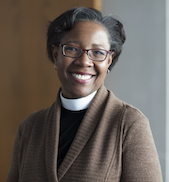
photo credit: Charlie Simokaitis
There is an iconic image of Barbara C. Harris as an acolyte at the ordination of the Philadelphia 11, 25 years before she would be consecrated the first female bishop in the Anglican Communion. It shows such promise for women’s ordained leadership in the Episcopal Church. But that promise, particularly for women of color, has yet to be fully realized.
The hope of the women’s ordination movement was that women would serve in positions of ordained leadership wherever they might be called to lead, whether in congregations or dioceses. Yet 40 years after General Convention voted to open the priesthood and episcopate to women, women of color are not well-represented as leaders of congregations. Today, more people of color attend predominately white congregations than historically racial or ethnic ones, and more Episcopalians are found in larger congregations than smaller ones, yet you’ll be hard pressed to find a female priest of color leading a predominately white parish of any size. In the Diocese of Chicago, where I serve, the numbers are unusually high. Out of our 126 faith communities, two black women lead predominately white congregations.
When I was ordained in 1997, there were some 30 black female priests serving as rector, vicar or priest-in-charge out of nearly 8,000 Episcopal congregations. Almost 20 years later, the Office of Black Ministries confirms that the number of black women leading congregations has continued to hover around the 30-40 mark. Historically, it has been easier for black men to be elected bishop of a diocese than to be elected rector of a white congregation. I suspect that for women of color, the odds are not much better.
This unfulfilled promise is not only a loss for the entire church, but it also sustains a false narrative that only “people who look like us” can minister to and with us. Can we all can truly see the image of God and the leadership gifts in the other when the other looks and presents very differently from us? For the sake of our church and the gospel, the answer must increasingly be “yes.”


